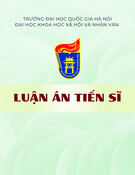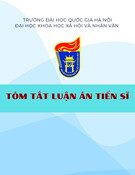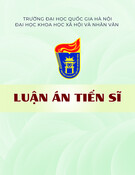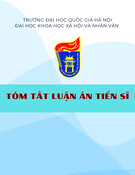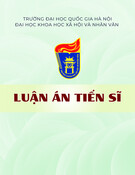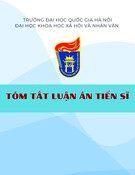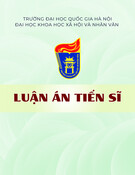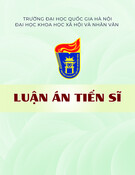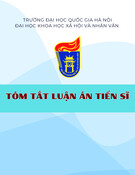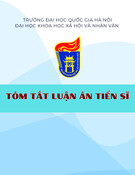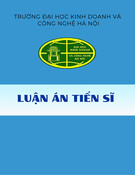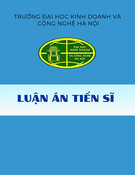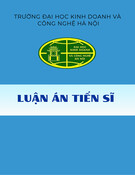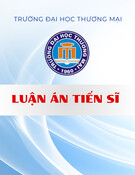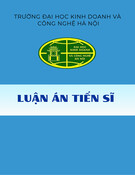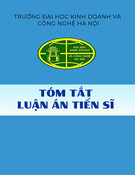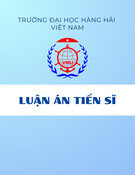MINISTRY OF EDUCATION AND TRAINING THAI NGUYEN UNIVERSITY NGA THI TO DANG STUDYING ON SOME TECHNIQUES TO DEVELOP DAISY FLOWER PRODUCTION IN THAI NGUYEN CITY Major: AGRONOMY Code: 62 62 01 01 DISSERTATION FOR DOCTOR OF PHYLOSOPHY IN AGRICULTURE THAI NGUYEN - 2011
RELATED PUBLICATIONS
1. Nga To Thi Dang, Van Thanh Dao, (2009), “Study on effects
of GA3 and Yogen No. 2 to yield and quality of Vang Thuoc
Duoc daisy flowers (Chrysanthemum sp.) in Thai Nguyen”,
Journal of Science and Technology, 13(62), Thai Nguyen
University Press, pp: 87 - 90.
2. Nga To Thi Dang, Van Thanh Dao, Linh Xuan Nguyen
(2010), “Study on effect of lighting time to Vang Thuoc Duoc
daisy flowers (Chrysanthemum sp.) in Thai Nguyen”, Journal
of Science and Technology, 14(76), Thai Nguyen University Press , pp: 41- 45.
1
INTRODUCTION
1. BACKGROUND
Daisy flowers were introduced to Vietnam from the XV century and
some small areas for daisy production have been formed to provide flowers
for people since XIX century. This flower is used for festivals, ritual
purposes or as one kind of medicine. Now daisy flowers are planted
everywhere from rural to urban, from upland to lowland areas in
Vietnam. Some intensely planting areas are Hanoi (450 ha), Ho Chi Minh
(370 ha), Da Lat (160 ha), Hai Phong (110 ha).
Thai Nguyen City is located in the Northwest of Hanoi (80 km far
from Hanoi), with a total area of 17,707.52 ha. The City is located nearby
National Highway 3, linking mountainous regions with lowlands. This
played an important role in social - economic development of Thai Nguyen
which is also a center for exchanging culture between Thai Nguyen and
Northern region. In addition, Thai Nguyen has a convenient transport
system and has many universities and colleges such as University of
Agriculture and Forestry, University of Education, University of Medicine,
University of Economics and Business Administration, College of
Education... Therefore, Thai Nguyen is a large consuming market of flowers
and the flower production in Thai Nguyen has a high economic efficiency.
However, the daisy varieties are still limited, the productivity and quality of
daisy flowers are low as well. To contribute to improving the productivity
and quality of daisy flowers in Thai Nguyen, we carried out the
techniques to develop daisy flower research: "Studying on some
production in Thai Nguyen City”.
2. RESEARCH OBJECTIVES AND REQUIREMENTS
- Selecting some daisy flower varieties that have high yield, good
resistance and are suitable with the ecological conditions for developing
flower production in Thai Nguyen and surrounding areas.
2
- Identifying some appropriate techniques to develop daisy flowers in
Thai Nguyen.
3. SCIENTIFIC AND PRACTICAL SIGNIFICANCE
3.1. Scientific significance
- The results of the research will provide scientific data on some daisy
flower varieties that are grown in Vietnam, especially in the ecological
conditions of Thai Nguyen. These are the results from studying the growth
and development of daisy flowers in two main seasons (Autumn-Winter
and Winter-Spring); initially identifying the daisy flower variety with high
yield - good flower quality and high economic efficiency; determining a
number of appropriate technical methods to improve the productivity and
quality of daisy flowers.
- The research results are the references of daisy flowers in Vietnam.
3.2. Practical significance
Determining the advantaged and disadvantaged factors to daisy
flower production and then recommending some methods to develop
daisy flowers in Thai Nguyen City. The research results on technical
methods will contribute to complete the guideline of daisy flower
production in Autumn - Winter and Winter - Spring seasons in Thai
Nguyen.
4. RESEARCH SCOPE
- Studying 30 imported and local daisy flower varieties to select the
variety/varieties that have high yield and quality.
- Research location: Thai Nguyen City.
- Research periods: From 2003 to 2008.
5. THE NEW FINDINGS OF THE THESIS
Based on the survey results of assessing the advantages and difficulties affecting to the daisy flower production in Thai Nguyen, the research results on varieties and farming techniques have confirmed the
3
possible development of daisy flowers in Thai Nguyen. Determining the growth, development and yield of some imported daisy flowers in Autumn - Winter and Winter - Spring seasons in Thai Nguyen and finding out 7 suitable varieties to Thai Nguyen condition (C5, C13, C19, CN20, Vang Thuoc Duoc, Do Bac Moi, Trang Dong Tien).
Some technical methods and determining the appropriate planting time for the new daisy flower variety (Vang Thuoc Duoc) have been studied. To have Vang Thuoc Duoc variety bloomed on 20 November occasion in Thai Nguyen, the planting date should be on 10 August and 20 August. Planting Vang Thuoc Duoc daisy flower on 22 November get it bloomed on New Year festival (The growth period is 88.3 days). Spraying a mixture of GA3 and foliar fertilizers (Yogen No. 2) increased flower height and number of first branches, increased pest resistance of Vang Thuoc Duoc in Winter-Spring season. The treatment of lighting additional 4 hours (from 22:00 to 2:00) gave good flower quality and high efficiency; We successfully implemented the demonstration of planting daisy flowers in Thai Nguyen City with Vang Thuoc Duoc and new production techniques. In the Winter-Spring, the profit was 11.79 millions VND per 360 m2 compared to 4.28 million VND in the control treatment. 6. STRUCTURE OF THE THESIS
The dissertation was fulfilled with 108 pages,
including an introduction and three chapters with 40 tables, 4 figures; 80 references including 35 references in Vietnamese and 45 references in English.
Chapter 1 LITERATURE REVIEW
1.1. Daisy flower production and research status in the world
The daisy flower studies have been conducted by many scientists around the world. Daisy flower varieties have been hybridized and grown in different ecological zones with the following main research contents:
- Forming a source of genetic material for hybridizing, selecting the
daisy flowers varieties that have good quality.
4
- Forming the variability by hybridizing and mutation by some agents to create new daisy flowers varieties that have new characteristics as well as colours and flower shapes.
- Testing daisy flowers in each different ecological condition to determine the best varieties that are stable, and have high adaptability to the testing condition.
- Identifying some technical methods for daisy flowers production to
have the best yield and flower quality. 1.2. Daisy flower production and research status in Vietnam
In the current daisy flowers production, there have been a lot of the imported daisy flowers that are grown in almost all provinces and cities around the country. The survey results on the areas of daisy flowers in Northern Vietnam by Dang Van Dong (2005) [8] showed that among 51 currently planted daisy flower varieties, there are 24 daisy flower varieties that have quite large planted areas: 88% total planted area. They are Vang Dai Loan (13.7%), CN98 (10.3%), CN97 (98.0%), CN93 (7.7%), CN01 (96.0%), Tim Sen (6%), 27 remaining varieties have small areas (<1%).
According to Dang Van Dong (2005) [8], in 2003 there were 9,430 ha of flowers and other ornamental plants in whole country with estimate value of 482.6 billion VND, of which the daisy flowers had 1,484 ha - the highest production value of 129.49 billion VND. Daisy was planted in many provinces around the country.
In the years 1996 - 1998, Nguyen Thi Kim Ly (2001) [22] collected and tested 30 local and imported daisy flower varieties and selected some promising daisy flower varieties in different seasons such as Spring - Summer and Summer - Thu (CN93, CN98, Tim Sen, Vang He Dalat varieties); Autumn - Winter (Vang Dai Loan, CN97, Cao Boi Tim, Hoa Mi varieties); Winter - Spring (Tim Xoay variety).
Dang Van Dong, Nguyen Quang Thach (2005) [9] conducted the experiment of light interrupting for Vang Pha Le variety in Winter season at 3 different light levels. The results showed that the time from planting to blooming in the control was 75.7 days which is 28 - 31 days shorter than other treatments. The quality of flower quality measured by stem diameters, flower height and flower mass in all treatments are higher than the control.
5
Study of Dang Ngoc Chi (2006) [3] on the planting dates of Dong
Tien Trang, Chi Xanh, Mat Troi, CN19, CN20, Cao Boi Tim and Tua
Vang showed that: The varieties: Dong Tien Trang, Chi Xanh, Mat Troi,
CN19, CN20 which was planted on 15 August bloomed exactly on 20
November vacation with relatively high flower quality; To get the variety
Cao Boi Tim had good flower quality on 20 November vacation, we need
to plant 5 - 10 days prior to 15 August. The variety of Tua Vang had long
growth time and had to accumulate enough temperature for blooming,
therefore it needed to plant at the beginning of July for blooming on the
occasion of 20 November.
When studying the effects of GA 3 products, foliar fertilizers , flower and fruit hormones to the yield and quality of daisy flowers that are grown
in Winter-Spring in the flower area of Hanoi, Nguyen Xuan Linh et al.
(2006) [19] concluded that all of GA 3, foliar fertilizers s, flower and fruit hormones significantly affected the growth and development of CN 97
daisy flower variety in Winter-Spring season. GA3 had the stronger effect on growth stages, the flower and fruit hormones gave higher effect on
development stages. Using a combination of GA 3, fertilizer, flower and fruit hormones increased plant height, flowers quality in the unfavorable
condition of flowering time.
Chapter 2
REASERCH CONTENTS AND METHODOLOGY
2.1. MATERIALS
- 30 daisy flower varieties were collected from the Centre of
ornamental plants and flowers - Institute of Agricultural Genetics and from
varieties in Thai Nguyen City.
- GA 3: white powder 1g/pack (Made in China). - Foliar fertilizers (Yogen No.2): N 30% P2O5 10%, 10% K2O (Made
in Yogen Mitsui Vina Company).
6
2.2. RESEARCH CONTENTS
- Investigating and evaluating the production and consumption of
flowers in Thai Nguyen City.
- Selecting daisy flower varieties that have high yield, good quality
and are suitable to ecological conditions in Thai Nguyen.
- Studying on technical methods to develop daisy flowers in Thai
Nguyen including:
+ Studying on effects of GA3 and Yogen No. 2 to yield and quality of
Vang Thuoc Duoc daisy flowers.
+ Studying effects of lighting time on the growth, development, yield
and quality of Vang Thuoc Duoc daisy flowers.
+ Identifying the planting dates of Vang Thuoc Duoc daisy flowers on
20 November occasion.
+ Identifying the planting dates of Vang Thuoc Duoc daisy flowers on
Vietnamese Lunar New Year.
- Building demonstration plot for daisy flowers production in Thai
Nguyen City.
2.3. METHODOLOGY
2.3.1. Investigating the production and consumption of flowers in Thai
Nguyen City
- Using RRA (Rapid Rural Appraisal) and KIP (Key Information
Person), through directly interview with a questionnaire prepared with the
following criteria:
+ Flower Production status.
+ The applied techniques in flower production.
+ Flower consumption status.
- Investigation location: Thai Nguyen City.
2.3.2. Field experiments
Experiment 1: Studying morphological characteristics, the growth and
development of daisy flower variety group in Thai Nguyen.
7
The experiment included 30 varieties of daisy flowers without
replication. The 3-week-old cuttings with roots were planted on the experiment area of 20m2 with density of 33 plants per m2; Plants were
grown in natural light conditions. The experiment was monitored in two
seasons: Autumn - Winter season in year 2003 and Winter - Spring in year
2003 - 2004 in Quan Trieu Ward - Thai Nguyen City. The plants were
grown on 15 August, 2003 in Autumn Winter season and 15 December,
2003 in Winter - Spring season.
Experiment 2: Studying growth, development, yield and quality of
some promising daisy flower varieties in Thai Nguyen.
The experiment consisted of seven promising daisy flower varieties
that are selected from the experiment of investigating daisy flower variety
group in 2 seasons Autumn - Winter and Winter - Spring in year 2003 - 2004.
The varieties were C5, C13, CN20 (control), Vang Pha Le, Vang Thuoc
Duoc, Do Bac Moi, Trang Dong Tien.
The experiment consisted of seven treatments, three replication with randomized complete block design (RCBD), plot area was 5 m 2. The
3-week-old cuttings with roots were planted with the density of 33 plants/m2; Plants were grown in natural light conditions. The experiment
was monitored in two seasons: Autumn - Winter, Winter - Spring in year
2004 - 2005 in Quan Trieu Ward - Thai Nguyen City. The plants were grown
on 15 August, 2004 in Autumn Winter season and 15 December, 2005 in
Winter - Spring season.
Experiment 3: Studying the effects of GA3 and Yogen No. 2 on Vang
Thuoc Duoc daisy flowers in Winter - Spring season.
The experiment consisted of four treatments, three replications: Water
Spraying (Control), GA3 100 ppm, Yogen No. 2 20g/8l, GA3 100 ppm +
Yogen No. 2 20g/8l.
8
The experiment was designed in randomized complete block design (RCBD), 5 m 2 for each plot. The 3-week-old cuttings with roots were planted with the density of 33 plants/m2; Plants were grown in natural light
conditions. The experiment was monitored in two seasons: Autumn - Winter
and Winter - Spring in year 2004 - 2005 in Quan Trieu Ward - Thai Nguyen
City. At the time of 15 days after planting, spraying all treatments 3 times
with a period of 10 days.
Experiment 4: Studying the effect of lighting time on the growth,
development and yield of Vang Thuoc Duoc daisy flowers.
- The experiment consisted of five treatments: Daisy flowers were
grown in natural light conditions (control), plus electric lighting of 0
(control), 2, 4, 6, 8 hours per night, respectively.
The experiment consists of five treatments; three replications with randomized complete block design (RCBD) and 5m2 for each plot. The experiment used circular bulb 100W with the density 5m 2 /1 bulb,
additional lighting after 10 PM. Do the lighting at the time of 10 days after
planting with consecutive 20 days . The experiment was conducted in
Winter - Spring in year 2005 - 2006 in Quan Trieu Ward - Thai Nguyen
City. Planting date was on 25 December, 2005.
Experiment 5: Studying the effect of planting time on the flowering
of Vang Thuoc Duoc daisy flowers on the 20 November occasion.
The experiment included five treatments from 1st, August to 10th
September, 2006. The experiment was designed in randomized complete
block design (RCBD) with 5 treatments and 3 replications. The area was 5 m 2 for each plot. The 3-week-old cuttings with roots were planted with the density of 33 plants/m2; Plants were grown in natural light conditions. The
experiment was conducted in Quan Trieu Ward - Thai Nguyen City.
Experiment 6: Studying the effect of planting time on the flowering
of Vang Thuoc Duoc daisy flowers on the Vietnamese lunar new year.
9
The experiment included five treatments from 2nd November to 11th December 2006. The experiment was designed in randomized complete block design (RCBD) with 5 treatments and 3 replications. The area was 5 m 2 for each plot. The 3-week-old cuttings with roots were planted with the density of 33 plants/m2; Plants were grown in additional light condition plus 4 hour lighting per each night (from 10 PM to 2 AM). At the time of 10 days after planting, the plants were lighted with 100W-bulb and 5m2/bulb in consecutive 20 days. The experiment was conducted in Quan Trieu Ward - Thai Nguyen City.
Experiment 7: Building demonstration plot for Vang Thuoc Duoc daisy
flowers production in Winter - Spring 2007 - 2008 in Thai Nguyen City.
- Model 1: Chi Trang variety + Traditional techniques - Model 2: Chi Trang variety + New techniques (4-hour-additional light +
GA 3 + foliar fertilizers + appropriate planting date in experiments 3, 4, 6). - Model 3: Vang Thuoc Duoc variety + Traditional techniques. - Model 4: Vang Thuoc Duoc variety + New techniques (4-hour- additional light + GA 3 + foliar fertilizers + appropriate planting date in experiments 3, 4, 6).
Each model was carried out in an area of 500 m 2 in 3 households in Quan
Trieu Ward, Thai Nguyen City on Lunar New Year occasion, 2007 - 2008.
2.3.3. Monitoring indicators
Observing and describing the basic morphological characteristics of collected daisy flower varieties, periods of growth and development (Greening, branching, budding, blooming), plant height and leaf emerging, the number of buds and flowers/plant, the length of cutting flowers, the number of petals/plant, yield, pest and diseases infected ratio, durability of cutting and durability of flowers in nature.
2.3.4. Data analysis
The collected information in the survey was stored using Excel 5.0 software. The experimental data was calculated, analyzed, processed using IRRISTAT 4.0 software.
10
Chapter 3
RESULTS AND DISCUSSION
3.1. INVESTIGATING THE FLOWER PRODUCTION AND CONSUMPTION STATUS IN THAI NGUYEN CITY 3.1.1. Status of flower production in Thai Nguyen 3.1.1.1. The structure of flower production area in Thai Nguyen City
The structure of flower production in the investigated communes shows that daisy flowers are planted with the largest area (3.84 ha) accounted for 41.7% of total flower areas.
The survey showed that in the Winter - Spring season, 100% flower production households had planted daisy flower with the largest area because it is easy to plant and cultivate daisy flowers in Winter - Spring crop (Vietnamese lunar new year); the flower from this crop had the biggest consumption in a year. There were 25.0 to 45.5% households planted daisy flowers in Autumn - Winter crops. Almost households believed that the climate in 2 crop seasons: Spring-Summer and Summer- Autumn was not favorable for daisy flowers to develop and the this flower consumption was not high at that time also. These are the reasons for them to not enlarge the daisy flower area.
Surveying on the application of
technical methods, almost interviewers said they used traditional techniques to cultivate daisy flowers (55.5 - 70.6%). Thus, information on technical advances have not been taught or have taught yet, but lack of specific guidance or high investment for new techniques is required, so that daisy flower production households have still not applied new techniques in their cultivation. However, some families have applied new techniques in planting daisy flowers (29.4 to 44.5%), especially in Winter-Spring crop because the daisy flowers response to short day light, so it needed to increase the lighting time to get the higher quality of daisy flowers. Almost those households believed that using new daisy flower varieties and new techniques would give much higher yield and daisy flower quality than the old ones.
11
3.1.1.2. The favorable and unfavorable factors for daisy flower
production in Thai Nguyen
Investigating the favorable factors for production of daisy flower
showed that the most favorable ones were easy to consume and required
average investment (selected by 100% households). The second favorable
factor was the land: 77.1% households thought that good land and near the
consumption market were favorable. Some flower growers could make use
of the land after harvesting summer rice to plant daisy flowers for
Vietnamese lunar new year occasion. That daisy flowers were easy to plant
and grow was the opinion of 80.1% households.
The survey also showed that the biggest difficulty was the shortage of
good varieties, 77.4% households believed that there was still lack of good
daisy flower varieties with high yield and flower quality. That was the
main difficulty to daisy flower production.
Pests and diseases were also factors that limited yield and quality of
daisy flowers. Up to 79.4% households thought that the factors such as
aphids, thrips, leaf spot disease and Rhizoctonia root rot caused the main
damage to daisy flower production. Lacking of technology is also an
important factor limiting production of daisy flower (selected by about
70.2% households).
In addition, erratic weather conditions of temperature, light, humidity
did affect the quality of flowers and could make flowers bloom early or
late and caused big loss for daisy flower growers (indicated by 69.5%
households).
3.1.2.4. Solutions to overcome the disadvantaged factors to daisy flower
production in Thai Nguyen
Based on the survey results, we realized that there were many
disadvantaged factors to daisy flower production in Thai Nguyen. The
12
problem of lacking good varieties with high yield and flower quality,
suitability with ecological condition, diseases, lacking of technical guidelines,
technology applying to planting daisy flowers. To develop daisy flower
production in Thai Nguyen, we propose some solutions as follows:
- Investigating, collecting and classifying the current daisy flower
varieties based on their response to the light.
- Determining the adaptability of daisy flower varieties and selecting ones with high yield and good quality suitable with ecological conditions and the flower demand of Thai Nguyen.
to - Applying new technical methods
improve daisy flower productivity, quality in Thai Nguyen: using foliar fertilizers and growth hormones, additional lighting, reasonable planting time etc. 3.2. RESULTS FROM SELECTING DAISY FLOWER VARIETIES WITH HIGH YIELD, GOOD QUALITY AND SUITABLE WITH ECOLOGICAL CONDITIONS IN THAI NGUYEN 3.2.1. Studying morphological characteristics, growth and development of daisy flower Group in Thai Nguyen
- Plant characteristics: The daisy flower varieties in experiments could be classified into three groups: high, medium, and low height. The varieties belonged to high plant type were: Cao Boi, C13, C19, Do Bac Moi, C5, Vang Thuoc Duoc. The varieties belonged to medium plant type were: C6, C7, Dau Do, Sao Nho, Da Bo and some low plant type varieties: Anh Bac, Vang Pha Le, Trang Dong Tien.
+ About the branch density: The varieties in experiments ranged from medium to dense density of branches. Almost varieties that had dense branches were small flower varieties; the others had bigger flowers.
+ Daisy plants shape was vertical, semi-vertical and semi-spherical type. Most daisy flower varieties had many branches and flower clusters, thus, some varieties belonged to vertical plant type such as C5, CN19, CN20, Cao Boi, Do Bac Moi, Canh Sen... Varieties belonged to semi- vertical plant type were: C7, C13, Vang Thuoc Duoc. Varieties belonged to semi-spherical plant type were Sao Nho, Chi Trang Chau.
13
- Characteristics of the stem colors were different among varieties: dark green, green, light green, violet, brown violet. Daisy flower varieties that had dark green stem were: C4, CN19, CN20, Vang Thuoc Duoc, Chi Nghe, Do Bac Moi. Varieties that had green stem were: C13, Vang Nhi Xanh, Trang Tuyet, and those with violet stem ones were Vien Tim, Muong Hong.
- Flower characteristics: All daisy flower varieties in experiments had medium or small flower diameter and almost served for cutting or pot planting purposes.
+ The color of daisy flower varieties were plentiful, variable with the colors like white, red, purple, yellow, pink, green or a flower with mixed colors such as: Dau Do, Muong Hong, Vien Tim, Tho Do.
+ Type and shape of daisy flower were quite complex. Some varieties were double flower type with tight-short-petal such as C5, C9, Vang Thuoc Duoc. Some varieties were single flower type with loose-pipe-petal such as Anh Bac, Muong Hong or other type was single flower with tigh-big-petal such as C13, Do To Ong, Trang Tuyet, Tim Hoa Ca.
From the preliminary research, we conducted the experiments to compare some promising daisy flower varieties. They were cluster branch daisy flower varieties: C5, C13, CN20, Vang Pha Le, Do Bac Moi, Vang Thuoc Duoc, Trang Dong Tien. These were varieties that had been planted and favored by the consumers due to their high plant type, erect leaf shape, medium flower diameter, high durability with favorable and plentiful flower colors. 3.2.2. Results from study on the growth, development, yield and quality of some promising daisy flower varieties in Thai Nguyen 3.2.2.1. Indicators on yield and quality of some promising daisy flower varieties in Autumn-Winter and Winter-Spring crops in Thai Nguyen
Results of monitoring flower yield - quality indicators of daisy flower
varieties in experiments were presented in Table 3.17.
14
Table 3.17: Some indicators of productivity, quality of some promising
daisy flower varieties in Autumn - Winter crop (2004) and Winter -
Spring crop (2004-2005) in Thai Nguyen
Autumn - Winter crop
Winter - Spring crop
Indicators
Number
Number
Number
Number
Number
Number
of
of
Flower
of
Flower
of buds/
of petals/
of buds/
flowers/
diameter
flowers/
diameter
petals/
plant
plant
flower
Varieties
plant
plant
flower
(cm)
(cm)
(buds)
(buds)
(petals)
(flower)
(petals)
(flower)
1. C5
14.1
12.0
353.2
3.9
12.8
10.5
339.0
3.8
2. C13
49.1
23.8
34.4
9.2
45.1
28.1
32.9
7.6
3. CN20 (Control)
28.6
19.7
36.4
4.0
27.4
26.2
34.2
3.2
4. Vang Pha Le
18.4
17.8
248.4
6.8
15.6
12.9
248.4
6.8
5. Do Bac Moi
51.0
47.1
49.0
5.3
50.0
48.2
45.0
4.8
6. Vang Thuoc Duoc
17.3
15.0
327.2
3.9
15.5
12.2
320.3
3.1
7. Trang Dong Tien
14.1
12.6
126.0
10.8
12.7
10.5
122.1
8.3
CV(%)
3.9
5.8
6.8
7.8
8.3
4.6
9.4
8.4
1.3
2.2
16.2
0.6
2.5
1.7
25.7
0.5
LSD05
- The number of buds per plant of daisy flower varieties in experiments in Autumn - Winter and Winter - Spring crops ranged largely whereas in both cropping seasons. DO Bac Moi variety had the highest buds number per plant (51.0 to 47.1 buds) and higher than the control. C5 variety had the least buds number per plant (14.0 to 12.8 buds) and fewer than the control.
- The number of flowers per plant of varieties in Autumn - Winter crop ranged from 12.0 to 47.1 flowers. Do Mac Moi variety had the highest number of flowers (47.1 flowers), C5 variety had the fewest number of flowers (12 flowers). In Winter - Spring crop, the number of flowers per plant varied from 10.5 (C5, Trang Dong Tien) to 48.2 flowers (Do Bac Moi).
- The number of petals per flower mainly depended on the characteristics of each variety, thus the its variation between two cropping
15
seasons: Autumn - Winter and Winter - Spring were not much but there were significant differences in number of petal per flower among varieties. Number of petals helps to distinguish single or double flower varieties, short or long flower durability. The varieties with many petals per flower usually have beautiful flower shape with semi-spherical flowers such as C5, Vang Thuoc Duoc. In experiments there were 4 varieties which had the highest number of petals per flower including C5 (353.2 to 339.0 petals), Vang Thuoc Duoc (327.2 to 320.3 petals), Vang Pha Le (248.4 petals), Trang Dong Tien (126.0 petals). The remaining varieties had the number of petals per flowers as high as the control of C20 variety. The Do Bac Moi had the lowest number of petals per flower (34.4 to 32.9 petals).
- Flower diameter had the difference among tested daisy flower varieties and between cropping seasons: Autumn - Winter and Winter - Spring. It meant that the Flower diameter depended not only on the genetic characteristics, but also depends on nutrient and ecological conditions. In Autumn - Winter crop, the flower diameter ranged from 3.9 cm to 10.8 cm. the variety with largest flower diameter was Trang Dong Tien (10.8 cm) and the smallest was C5 (3.9 cm). In Winter - Spring the flower diameter varied from 3.1 cm - 8.3 cm and the largest flower diameter was Trang Dong Tien Variety (8.3 cm) and the smallest was Vang Thuoc Duoc (3.1 cm). 3.2.2.2. Economic efficiency of promising daisy flower varieties in Thai Nguyen The economic efficiency calculation table showed that Vang Thuoc Duoc and C5 varieties had the highest price compared to others and the flower yield was high, thus it had the highest return per investment capital (2.28 and 2.00 times). Especially Vang Thuoc Duoc with medium circle, semi-spherical flower with tight-light yellow - petals, was most enjoyable by almost consumers.
Based on the experiment results and consulting with the flower growers in the trial production, economic efficiency from production of daisy flower varieties in the experiments, we have chosen Vang Thuoc Duoc variety to study some technical methods to improving the flower yield and quality.
16
3.3. STUDY RESULTS OF SOME TECHNICAL METHODS FOR HIGHER YIELD AND QUALITY OF VANG THUOC DUOC DAISY FLOWER VARIETY IN THAI NGUYEN 3.3.1. Results of study on the effect of GA3 and Yogen No. 2 on yield and quality of Vang Thuoc Duoc daisy flower
Results of monitoring the effects of GA 3 and Yogen No. 2 on yield and
quality of Vang Thuoc Duoc daisy flower were presented in Table 3.25.
Table 3.25: Effects of GA3 and Yogen No. 2 on yield and quality of Vang Thuoc Duoc daisy flower in Winter-Spring season
(2004-2005) in Thai Nguyen
Indicators
Flower diameter (cm)
Number of buds/ plant (buds)
Number of petals/ flower (petals)
Durability of flowers in nature (days)
Durability of cutting flowers (days)
Treatments
Number of flowers/ plant (flowers)
Ratio of real cutting flowers (%)
16.6
11.7
316.3
17.3
85.5
2.8
13.3
327.3
13.3
90.3
327.0
13.3
89.3
324.3
13.3
95.3
17.3 17.3 17.7 4.2
12.2 11.9 12.1 6.2
3.1 3.1 3.2 5.5
18.1 18.1 19.0 3.3
1.45
1.48
0.33
1.17
1.Water sprayed (control) 2.GA3 3.Yogen No. 2 4.GA3+Yogen No.2 CV ( %) LSD05
The Table 3.25 showed that: - The number of buds per plant of treatments ranged from 16.6 to 17.7 buds. The treatment 1 (control) had the lowest number of buds (16.6) and treatment 4 (GA 3 + Yogen No. 2) had the highest number of buds that reached 17.7 buds.
- Number of flowers per plant: The number of flowers per plant among treatments were not much different, ranging from 11.7 to 12.2 flowers. However, there is no statistical significant difference among treatments.
- Diameter of flowers in treatments ranged from 2.8 to 3.1 cm. The treatments 1 (control) had the smallest flower diameter (2.8 cm), the
17
highest one was treatment 4 (GA spray 4 + Yogen No .2) (3.2 cm) and higher than the control.
- Number of petals: There is variation among treatments from 316.3 to 327.3 petals. The water spraying treatment has the lowest number of petals (316.3 petals), followed by treatment of GA 3 + Yogen No. 2 (324.3 petals). Both treatments: GA 3 (327.3) and Yogen No. 2 (327.0) had higher number of petals than the control.
- Flower durability: The durability of cutting flowers have no reliable differences among the treatments, natural durability of the treatments varied from 17.3 to 19.0 days. After analyzing, we could see that treatment 2, 3 had no significant difference from the controls. Treatment 4 had the natural durability which is significantly longer than the controls at 95% confidence level.
to - The actually harvested flower rates varied from 85.5 95.3%. Treatment of Spraying GA3 + Yogen No. 2 had the highest rate (95.3%) and the lowest rate was the control (85.5%).
3.3.2 Results of studying the effects of additional light on yield and quality of Vang Thuoc Duoc daisy flower
- Flower Height: Ranged from 67.8 - 71.0 cm in treatments of light, significantly higher than the control (control: 43.2 cm); treatment 5 (8 hours) had the highest plant height (67.8 cm), while the lowest plant height was treatment 1 (control)
- The number of buds and flowers per plants: Treatments with additional light has buds ranging from 17.9 to 22.3 buds (more than the control 8.1 buds per plant); treatment 3 (4 hours) had the highest buds (22.3 buds). The results suggested that if additional lighting time is long (6 to 8 hours), the number of buds will decrease, as the flower splitting process of the plant was inhibited.
Similarly, the number of flowers per plant in treatments with additional lighting varied from 14.3 to 17.1 flowers, significantly higher than the control by 6.6 to 9.6 flowers (the control was 7.5 flowers).
18
Table 3.29: Effects of additional lighting time on yield and quality of Vang Thuoc Duoc daisy flowers in Winter-Spring crop (2005-2006) in Thai Nguyen
Indicators
Flower diameter (cm)
Plant height (cm)
Durability of cutting flowers (days)
Number of buds/ plant (buds)
Number of petals/ flower (petals)
Ratio of real cutting flowers (%)
Durability of flowers in nature (days)
Number of flowers/ plant (flowers)
43.2 69.4 68.7 67.8 71.0 6.7 8.137
8.5 18.6 22.3 17.9 19.7 9.5 3.106
7.5 14.3 17.1 15.1 15.6 7.0 1.824
3.2 3.3 3.5 3.3 3.3 1.9 0.119
322.7 328.9 335.3 329.7 332.8 1.7 10.505
11.3 12.9 14.2 13.3 12.8 4.1 0.994
17.0 17.9 18.6 17.7 17.2 3.6 1.194
82.3 92.3 96.6 97.0 98.5
Treatments 1 (control) 2 (2 h) 3 (4 h) 4 (6 h) 5 (8 h) CV (%) LSD05
- Flower Diameter and petal per flower: All treatments with additional lighting had larger flower diameter than the control (3.2 cm). They ranged from 3.3 to 3.5 cm in flower diameter and from 328.9 to 335.2 petals per flower. Treatment 3 (4 hours) had the biggest flower diameter (3.5 cm) with 335.2 petals/flower, higher than the control at 95% confidence level. Others had the equivalent flower diameter (3.3 cm) and higher than the con troll at the reference of 95%.
- Durability of cutting flowers in treatments varied from 12.8 to 14.2
days higher than the control (11.3 days).
- Durability of flower in nature: The durability of all treatments varied from 17.2 to 18.6 days. The treatment 3 (4 hours) had the highest Durability of flower in nature (18.6 days), significant higher than the control at the 95% confidence level. The other treatments had durability as long as the control.
- The ratio of harvested flowers: Treatment 2, 3, 4, 5 that had additional lighting time gave the higher ratio than the control (treatment 1) from 10.0 to 17.2%. Treatment 5 (8 hours) gave the highest ratio (98.5%). 3.3.3. Results of studying the effects of planting date on the blooming of Vang Thuoc Duoc Daisy flower on 20th November occasion 3.3.3.1. Period of growth and development of Vang Thuoc Duoc Daisy flowers Results of monitoring the periods of growth and development are
represented in Table 3.31.
19
- The time from planting to green in the treatments was not much different ranging from 5 - 6 days due to the high temperature and sunny at the beginning of planting season that made the long recovery time.
- The time from planting to branching (80% treatments) varied from 39 to 60 days in which the shortest was treatment 5 (39 days) and longest was the first treatment (60 days).
- The time from planting to budding (80% treatments) varied from 44 to 74 days. Treatment 5 was the fastest one to bud (44 days), the treatment 1 had the longest time at 74 days.
Indicators
- The time from planting to flowering (80% treatments) ranged from 81 to 98 days. Treatment 5 had the fastest flowering time (81 days), the treatment 1 had the longest time (98 days). Treatment 2, 3, 4 had the flowering time ranging from 83 to 96 days. Table 3.31: Effects of planting date on the growth and development of Vang Thuoc Duoc daisy flower on 20th, November occasion in Thai Nguyen (Unit: days) Growth time (from planting to.......)
Branching Bud emerging Blooming
Greening
Blooming dates (80%)
20%
80% 20%
80%
20% 80%
Planting dates
6
52
60
68
74
78
98
Nov 7
1. (August 1)
6
49
58
64
66
76
96 Nov 14
2. (August 10)
6
44
50
61
69
74
90 Nov 18
3. (August 20)
6
36
43
44
48
68
83 Nov 22
4. (August 30)
5
32
5. (September 10)
39
65
40
44
81 Nov 30 - The time from planting to green in the treatments was not much different ranging from 5 - 6 days due to the high temperature and sunny at the beginning of planting season that made the long recovery time.
- The time from planting to branching (80% treatments) varied from 39 to 60 days in which the shortest was treatment 5 (39 days) and longest was the first treatment (60 days).
- The time from planting to budding (80% treatments) varied from 44 to 74 days. Treatment 5 was the fastest one to bud (44 days), the treatment 1 had the longest time at 74 days.
20
- The time from planting to flowering (80% treatments) ranged from 81 to 98 days. Treatment 5 had the fastest flowering time (81 days), the treatment 1 had the longest time (98 days). Treatment 2, 3, 4 had the flowering time ranging from 83 to 96 days. 3.3.3.2. Influence of planting date on the economic efficiency of Vang Thuoc Duoc daisy flower on 20th, November occasion Table 3.32. Economic efficiency of each planting date of Vang Thuoc Duoc daisy flowers crop on 20th, November occasion in Thai Nguyen
Indicators
Area: 360m2 Benefit compared to
Benefit (VND)
Total investment (VND)
Total revenue (VND)
control (times)
Planting date
0.66
3,160,900
6,700,200 2,524,100
1. (August 1)
1.00
3,160,900
7,733,600 3,833,100
2. (August 10)
1.40
3,160,900
8,553,600 5,370,900
3. (August 20)
0.43
3,160,900
6,272,400 1,654,500
4. (August 30)
0.50
5. (September 10)
3,160,900
6,415,200 1,901,500
Of all planting date treatments, the time of harvesting flowers had a big effect on the economic efficiency of the flower production. In treatments 2, 3, flowers bloomed mainly on November 14 and 18, at these time the price was high at 1,000 VND - 1,200 VND per flower, thus the interest in treatment 2, 3 was 1,654,500 to 5,370,925 VND per 360m2, much higher than other treatments. Treatment 1, 4, 5 had the flower bloomed on other dates, the price was lower than on 20th, Nov (600 VND per flowers), so the interest was lower than treatment 2, 3. 3.3.4. Studying the effects of planting date on the blooming of Vang Thuoc Duoc daisy flower on Vietnamese lunar New Year in Thai Nguyen 3.34.1. The period of growth and development of Vang Thuoc Duoc daisy flower variety
- The period from planting to branching (80%) of treatments in the Winter - Spring was relatively short and descended from treatment 1 to 5, varied from
21
39.0 to 46.3 days. Treatment 1 had the longest time of 80% branching (46.3 days) and treatment 5 had the shortest time branching (39 days).
Table 3.33. Effects of planting date on the growth and development of Vang Thuoc Duoc daisy flower on Vietnamese lunar New Year in Thai Nguyen
Unit: Days
Indicators
Growth time (from planting to.......)
Branching Bud emerging Blooming
Greening
Blooming dates (80%)
20%
80%
20%
80%
20% 80%
Planting date
5
41.0
46.3
44.7
53.0
78.3 94.0
Feb 4
1. (Nov 2)
5
38.5
42.7
37.1
48.4
77.7 92.7 Feb 13
2. (Nov 12)
5
37.7
41.2
36.7
44.3
75.0 88.3 Feb 17
3. (Nov 22)
6
36.3
40.5
35.7
42.7
75.7 86.3 Feb 26
4. (Dec 2)
5. (Dec 12)
6
35.7
39.0
35.3
42.0
74.3 85.7 March 8
(Control)
- The period from planting to budding (80%) was most early in
treatment 5 (42 days) and latest in treatment 1 (53.0 days).
- The period from planting to flowering (80%) of the treatments decreased from treatment 1 (94.0 days) to treatment 5 (85.7 days). Of all treatments, treatment 1 bloomed 13 day earlier than the lunar New Year (February 4), treatment 2 bloomed exactly on lunar New Year (February 17). Treatment 4, 5 bloomed later than lunar New Year.
3.3.4.2. The effects of planting date to the economic efficiency of Vang Thuoc Duoc daisy flowers on Vietnamese lunar New Year
Vang Thuoc Duoc variety is one kind of daisy flowers that have a bright yellow color, good flower shape, high flower durability and have high appreciate from customers, especially on Vietnamese lunar New Year (Tet). We conducted a preliminary economic efficiency calculation and the results shown in Table 3.3 6.
22
Table 3.36. Economic efficiency of each planting date of Vang Thuoc Duoc daisy flowers crop Vietnamese lunar New Year in Thai Nguyen Unit areas: 360 m2
Benefit
Indicators
Total
compared
investment
Interest
Total revenue
to control
(VND)
(VND)
(VND)
(times)
Planting date
0,4
1. (Nov 2)
4,106,900
7,028,400
2,921,500
0,7
2. (Nov 12)
4,106,900
9,313,600
5,206,700
1,3
3. (Nov 22)
4,106,900
13,914,000
9,807,100
0,4
4. (Dec 2)
4,106,900
6,885,600
2,778,700
1,0
5.(Dec 12) (Control)
4,106,00
11,524,000
7,417,100
Table 3.36 showed that: All five treatment of planting Vang Thuoc
Duoc had interest but different. Treatment 3 had the highest interest (due to
the blooming on Tet making the higher price than normal days) that was
interest was higher than usual the
9,807,100VND. But treatment of planting on December 12 had flower blooming on 8th, March, so (7,417,100VND). Other treatment had the interest ranged from 2,778,700
VND to 5,206,700 VND.
Therefore, we can select treatment 3 (planted on November 22) as
the main planting date for Vang Thuoc Duoc daisy flower variety to
bloom exactly on Tet and the other treatments all had quite high and
stable interest. This demonstrates that the need of using flowers in months after Tet holiday is still very high (weddings, festivals, temples, 8th march... usually focus on January or February in lunar year).
23
3.5. BUILDING DEMONSTRATION FOR DAISY FLOWER
PRODUCTION IN QUAN TRIEU WARD, THAI NGUYEN CITY
THAI NGUYEN PROVINCE
Table 3.38. Economic efficiency in daisy flower model in Thai Nguyen City
Actual
Interest
Compar
Compar
Compared
Investment
Model
to Model 1 (%)
efficiency (%)
yield (flowers/ 360m2)
(millions VND/ 360m2)
ed to Model 2 (%)
ed to Model 3 (%)
10,098
4.25
100
-
-
2.1
Model 1 (control)
Model 2
11,048
8.30
195
100
-
2.8
Model 3
10,573
6.75
159
81
100
2.7
Model 4
11,167
11.79
277
142
175
3.4
Table 3.38 showed that the highest economic efficiency in the model 4 due to using new daisy flower variety (Vang Thuoc Duoc) and applying new techniques which are additional lighting from 22h - 2h and planting flowers for Tet holiday, so the economic efficiency was high, the interest was 11.79 million VND/ 360m 2. Model 1 had the lowest interest that achieved 4.25 million VND/360m 2 due to using the popular variety (Chi Trang), applying traditional technique (natural light), thus the flower yield, quality and economic efficiency were low.
Model 2 used common variety (Chi Trang) but applied new technical method, thus the interest reached 8.3 million VND/360m2. Model 3 used new variety (Vang Thuoc Duoc) and applied traditional technique, the interest was 6.75 million/360m2. In short, model 4 (using Vang Thuoc Duoc variety and applying new technique) gave the high economic efficiency, model 1, 2, 3 gave lower one.
CONCLUSION AND PROPOSITION
1. CONCLUSION
- Thai Nguyen City is very favorable for the development of flower production, where daisy flowers are planted in largest area (41.7% compared to other flowers).
24
- 30 studied daisy flower varieties have had the ability to adapt to the ecological conditions of Thai Nguyen, of which there are seven daisy flower varieties with high yield and high quality flowers as C5, C13, CN20, Vang Thuoc Duoc, Do Bac Moi, Trang Dong Tien, Vang Pha Le. Vang Thuoc Duoc variety was planted in Autumn - Winter and Winter - Spring crops gave high yield, good quality and high economic efficiency.
- Spraying GA 3 100 ppm + foliar fertilizer Yogen No.2 20g/8l increased plant height and number of first branches, increased pest resistance of Vang Thuoc Duoc variety in Winter - Spring crop.
- Additional lighting for Vang Thuoc Duoc daisy flower variety 4 hours/night (from 22h to 2h) gave good flower quality and high economic efficiency.
- The planting date of Vang Thuoc Duoc daisy flower variety to harvest on 20th, Nov occasion was on August 10 to 20 (Growing time was 90-96 days).
- The planting date of Vang Thuoc Duoc daisy flower variety to harvest
on Tet holiday was on November 22 (Growing time was 88.3 days).
- The model using additional light (4 hours/night) on Tet holiday for Vang Thuoc Duoc brought the high economic efficiency (reaching 11.79 million VND/360m2). 2. PROPOSITION
- Using Vang Thuoc Duoc variety in producing daisy flowers in
Autumn - Winter and Winter - Spring crops in Thai Nguyen.
- It can be sprayed GA 3 100 ppm mixed with foliar fertilizer Yogen
No. 2 20g/8l to increase the quality of flowers in Winter-Spring crop.
- Vang Thuoc Duoc daisy flowers that are planted in Winter - Spring crops need an additional lighting time of 4 hours per night (from 22h to 2h) in 20 days to improve productivity and quality of flowers.
- It can select the planting date on August 10 to 20 (Growing time was 90-96 days) to have Vang Thuoc Duoc daisy flower variety harvested on 20th, Nov in the natural light condition. The planting date for harvesting Vang Thuoc Duoc daisy flowers on Tet holiday is on 22nd, Nov (Growing time is 88.3 days) in the condition of 4 hours additional light each night (from 22h to 2h) in 20 days.

